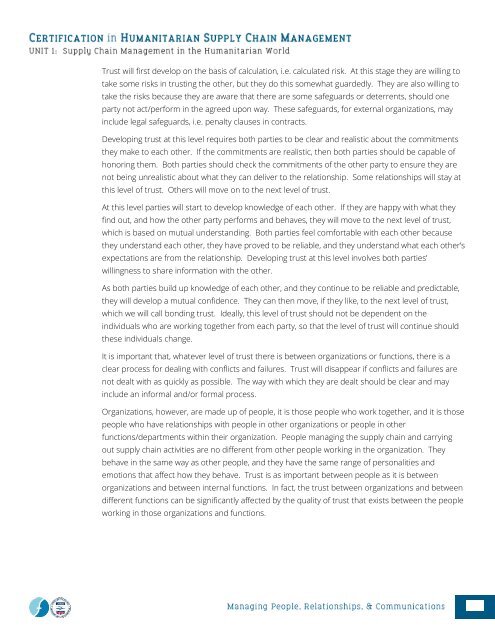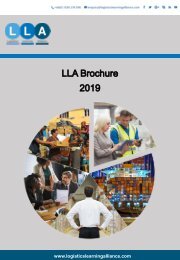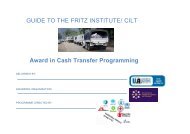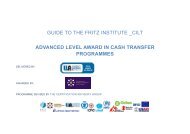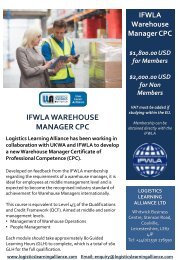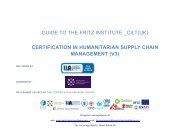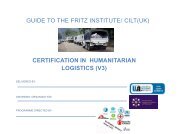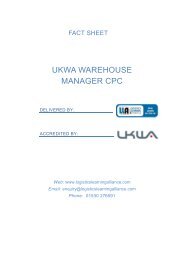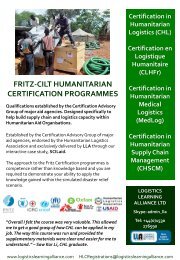CHSCM 3.0 - Unit 1 - SCM in the Humanitarian World
Learning Materials for Unit 1 of the Certification in Humanitarian Supply Chain Management (CHSCM).
Learning Materials for Unit 1 of the Certification in Humanitarian Supply Chain Management (CHSCM).
Create successful ePaper yourself
Turn your PDF publications into a flip-book with our unique Google optimized e-Paper software.
Trust will first develop on <strong>the</strong> basis of calculation, i.e. calculated risk. At this stage <strong>the</strong>y are will<strong>in</strong>g to<br />
take some risks <strong>in</strong> trust<strong>in</strong>g <strong>the</strong> o<strong>the</strong>r, but <strong>the</strong>y do this somewhat guardedly. They are also will<strong>in</strong>g to<br />
take <strong>the</strong> risks because <strong>the</strong>y are aware that <strong>the</strong>re are some safeguards or deterrents, should one<br />
party not act/perform <strong>in</strong> <strong>the</strong> agreed upon way. These safeguards, for external organizations, may<br />
<strong>in</strong>clude legal safeguards, i.e. penalty clauses <strong>in</strong> contracts.<br />
Develop<strong>in</strong>g trust at this level requires both parties to be clear and realistic about <strong>the</strong> commitments<br />
<strong>the</strong>y make to each o<strong>the</strong>r. If <strong>the</strong> commitments are realistic, <strong>the</strong>n both parties should be capable of<br />
honor<strong>in</strong>g <strong>the</strong>m. Both parties should check <strong>the</strong> commitments of <strong>the</strong> o<strong>the</strong>r party to ensure <strong>the</strong>y are<br />
not be<strong>in</strong>g unrealistic about what <strong>the</strong>y can deliver to <strong>the</strong> relationship. Some relationships will stay at<br />
this level of trust. O<strong>the</strong>rs will move on to <strong>the</strong> next level of trust.<br />
At this level parties will start to develop knowledge of each o<strong>the</strong>r. If <strong>the</strong>y are happy with what <strong>the</strong>y<br />
f<strong>in</strong>d out, and how <strong>the</strong> o<strong>the</strong>r party performs and behaves, <strong>the</strong>y will move to <strong>the</strong> next level of trust,<br />
which is based on mutual understand<strong>in</strong>g. Both parties feel comfortable with each o<strong>the</strong>r because<br />
<strong>the</strong>y understand each o<strong>the</strong>r, <strong>the</strong>y have proved to be reliable, and <strong>the</strong>y understand what each o<strong>the</strong>r’s<br />
expectations are from <strong>the</strong> relationship. Develop<strong>in</strong>g trust at this level <strong>in</strong>volves both parties’<br />
will<strong>in</strong>gness to share <strong>in</strong>formation with <strong>the</strong> o<strong>the</strong>r.<br />
As both parties build up knowledge of each o<strong>the</strong>r, and <strong>the</strong>y cont<strong>in</strong>ue to be reliable and predictable,<br />
<strong>the</strong>y will develop a mutual confidence. They can <strong>the</strong>n move, if <strong>the</strong>y like, to <strong>the</strong> next level of trust,<br />
which we will call bond<strong>in</strong>g trust. Ideally, this level of trust should not be dependent on <strong>the</strong><br />
<strong>in</strong>dividuals who are work<strong>in</strong>g toge<strong>the</strong>r from each party, so that <strong>the</strong> level of trust will cont<strong>in</strong>ue should<br />
<strong>the</strong>se <strong>in</strong>dividuals change.<br />
It is important that, whatever level of trust <strong>the</strong>re is between organizations or functions, <strong>the</strong>re is a<br />
clear process for deal<strong>in</strong>g with conflicts and failures. Trust will disappear if conflicts and failures are<br />
not dealt with as quickly as possible. The way with which <strong>the</strong>y are dealt should be clear and may<br />
<strong>in</strong>clude an <strong>in</strong>formal and/or formal process.<br />
Organizations, however, are made up of people, it is those people who work toge<strong>the</strong>r, and it is those<br />
people who have relationships with people <strong>in</strong> o<strong>the</strong>r organizations or people <strong>in</strong> o<strong>the</strong>r<br />
functions/departments with<strong>in</strong> <strong>the</strong>ir organization. People manag<strong>in</strong>g <strong>the</strong> supply cha<strong>in</strong> and carry<strong>in</strong>g<br />
out supply cha<strong>in</strong> activities are no different from o<strong>the</strong>r people work<strong>in</strong>g <strong>in</strong> <strong>the</strong> organization. They<br />
behave <strong>in</strong> <strong>the</strong> same way as o<strong>the</strong>r people, and <strong>the</strong>y have <strong>the</strong> same range of personalities and<br />
emotions that affect how <strong>the</strong>y behave. Trust is as important between people as it is between<br />
organizations and between <strong>in</strong>ternal functions. In fact, <strong>the</strong> trust between organizations and between<br />
different functions can be significantly affected by <strong>the</strong> quality of trust that exists between <strong>the</strong> people<br />
work<strong>in</strong>g <strong>in</strong> those organizations and functions.


